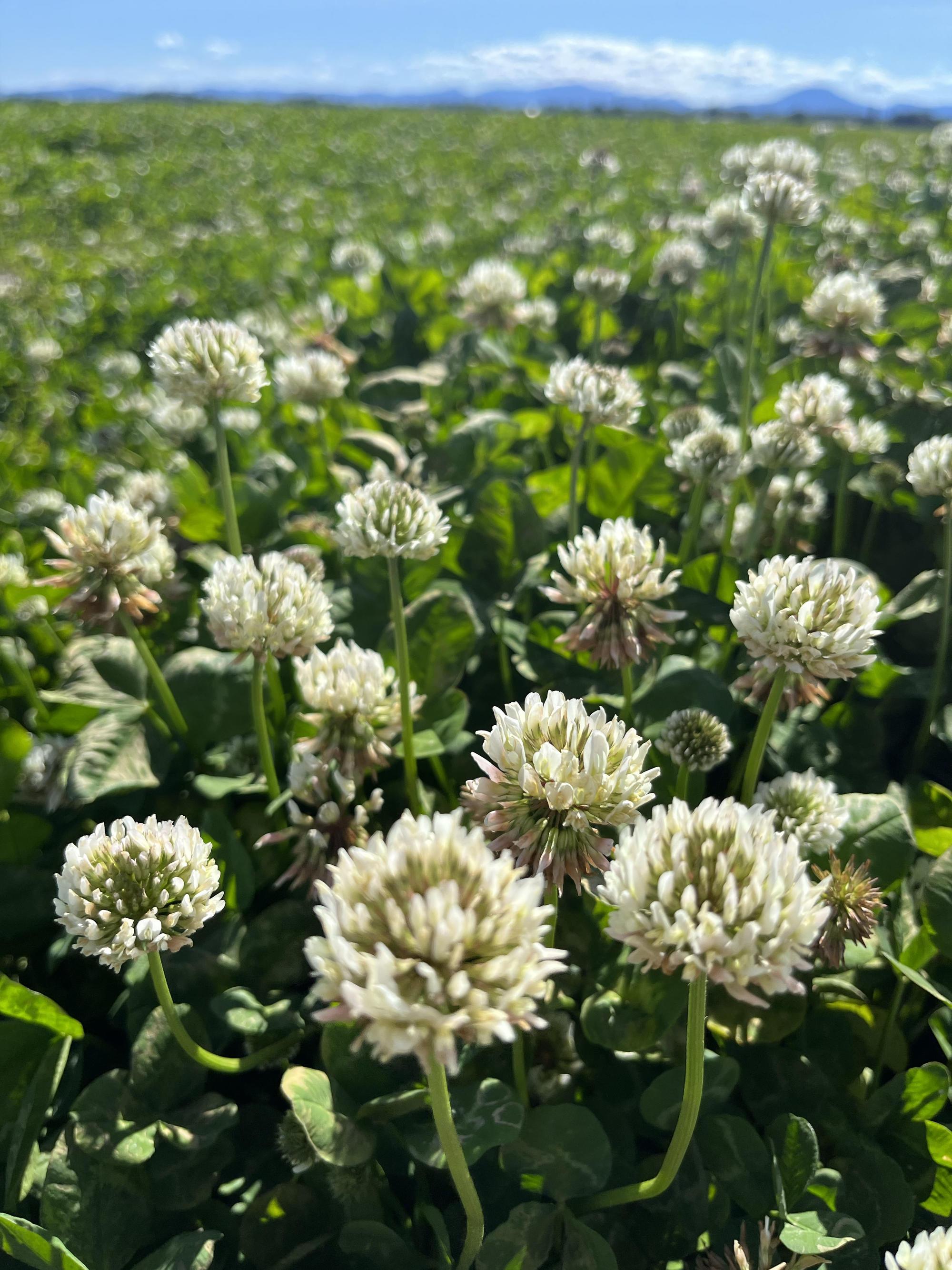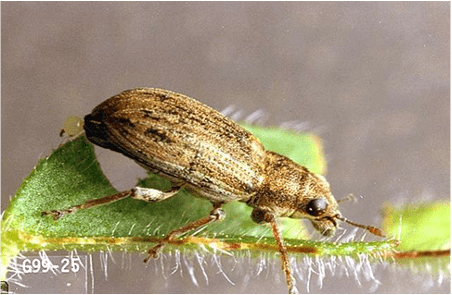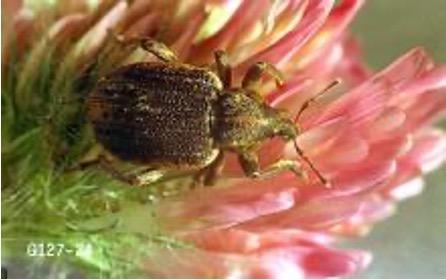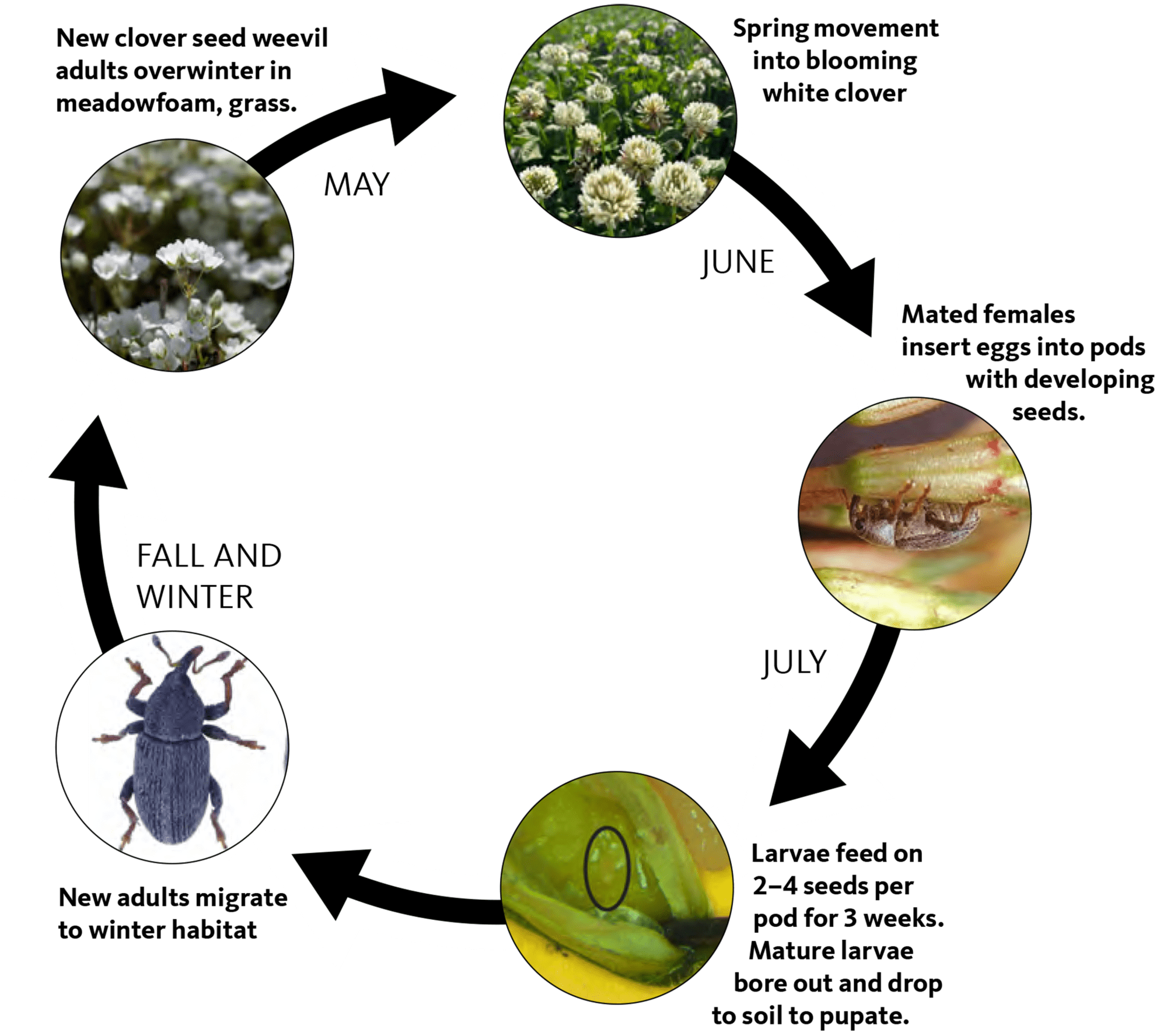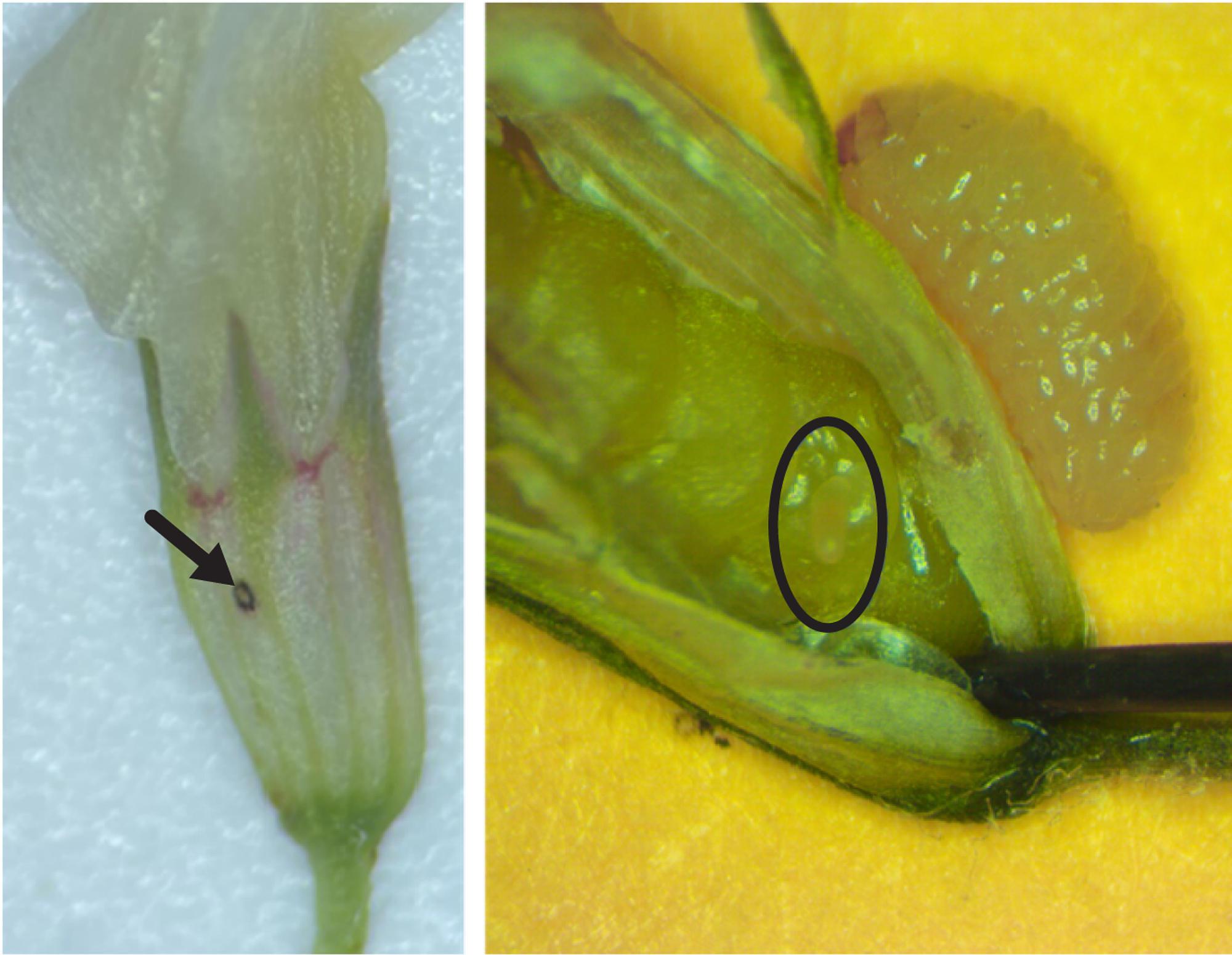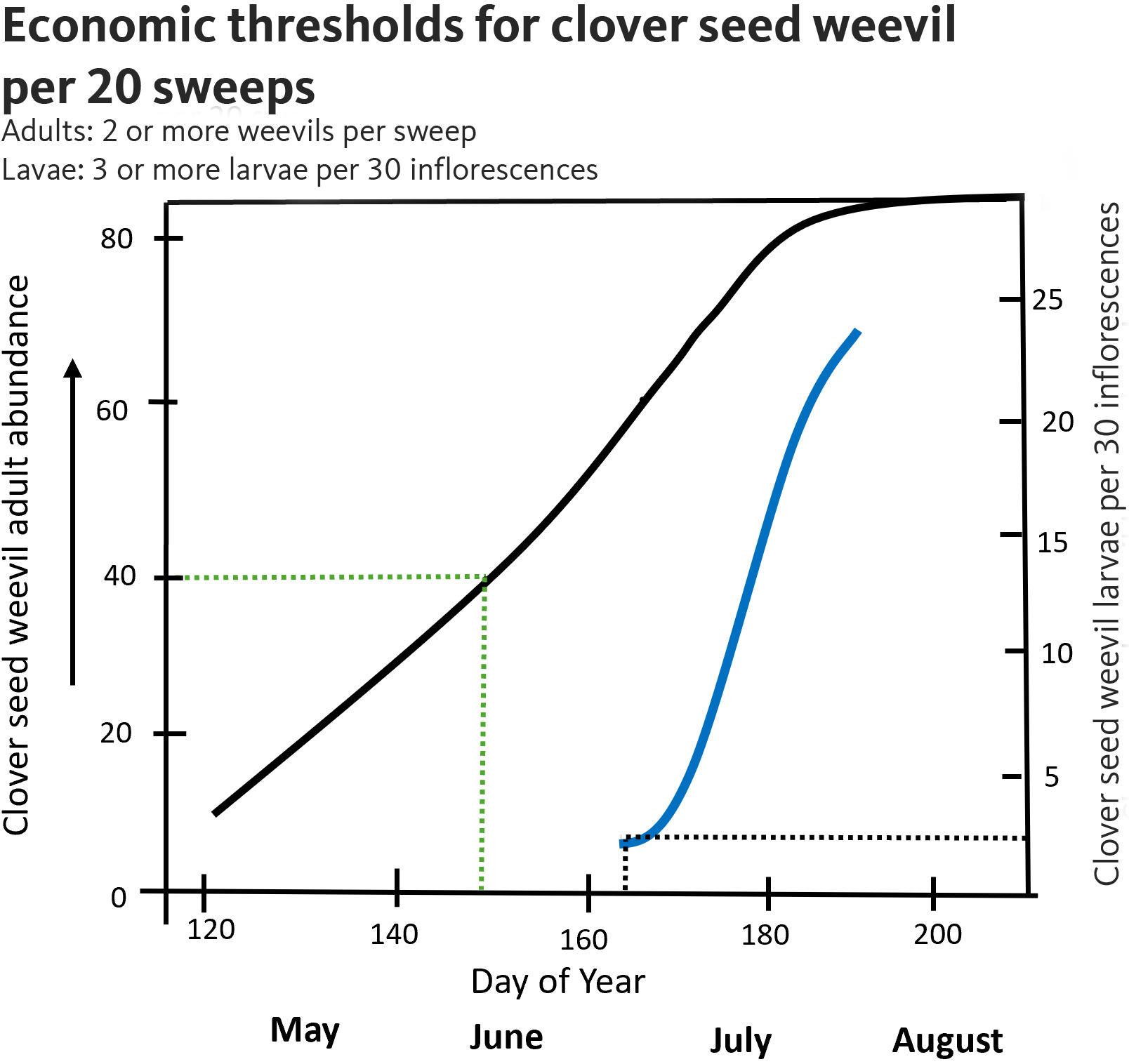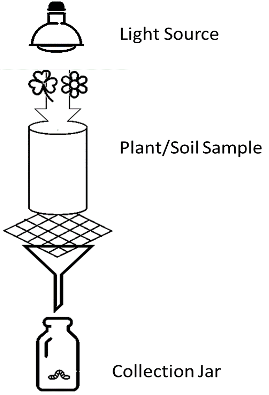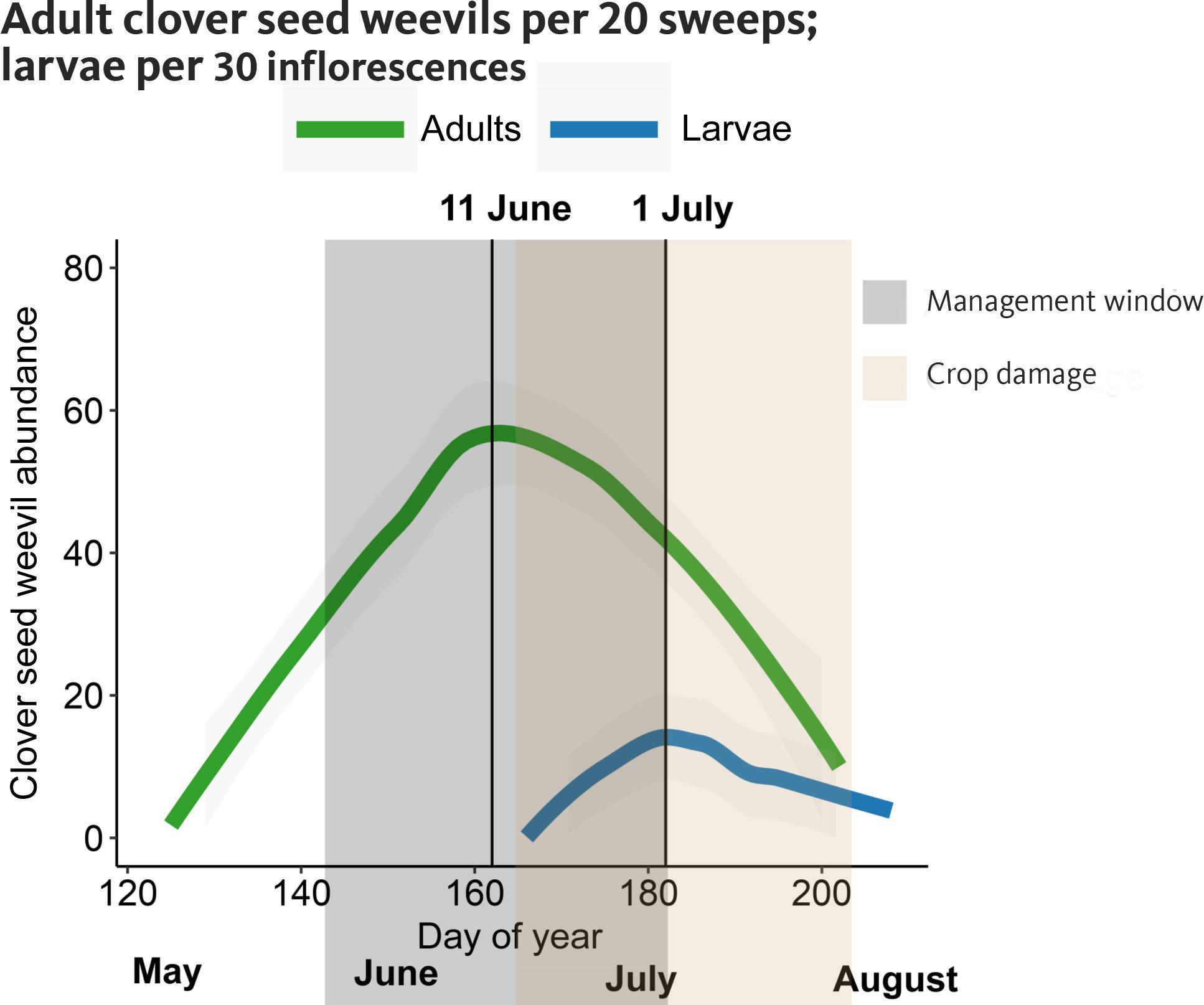Forage legume seed crops such as white clover (Trifolium repens L.) (Figure 1), are vital for seed production enterprises and valuable rotation crops for Oregon’s grass seed production systems. White clover performs well in areas with heavy clay soils, such as the south Willamette Valley, where growers have few options for economically viable rotation crops due to lack of drainage. White clover seed yield depends on flower head density, which is affected by environmental conditions, agronomic and pest management, and cultivar selection.
Among insect pests, a small weevil (0.1 inches long) commonly known as clover seed weevil, Tychius picirostris (Fab.) (Coleoptera: Curculionidae), has been identified as one of the primary factors limiting seed yield potential. Clover seed weevil adults have characteristically long snouts. Gray and white hair covers their bodies (Figure 2).
Crop damage is mainly caused by the larvae, which are plump, legless and approximately 0.1 inches long. They have white bodies and pale, brown heads bearing distinct black eyes, often partly curled (Figure 2). These larvae feed on the developing seed inside the pods, resulting in yield loss. In addition to white clover, alsike clover (Trifolium hybridum L.) and arrowleaf clover (Trifolium vesiculosum L.) are susceptible to clover seed weevil feeding damage.
The clover seed weevil originated in Europe, and its entry to North America is dated prior to 1920. Existing records note damage from the clover seed-growing regions of the Pacific Northwest beginning in 1934. Subsequently, clover seed weevil has become a priority pest in white clover seed crops grown in Oregon’s Willamette Valley. This is due to proximity of the host crop to habitat where the weevils overwinter. Clover seed weevil adults spend the fall and winter months, when clover crops are not in bloom, in patches of volunteer meadowfoam and wild grasses — Lolium, Poa, and Festuca species growing in field ditches. Each spring, weevils migrate to clover seed fields.
In Oregon white clover seed production systems, continuous use of broad-spectrum pyrethroid insecticides (e.g. bifenthrin) has exerted high selection pressure on clover seed weevil populations, leading to reduced efficacy and limited control due to insecticide resistance documented by OSU in 2022.
This publication provides general information about the clover seed weevil, including life cycle, crop damage and scouting. Producers will learn management strategies to reduce clover seed damage in white clover production systems.
Other weevil pests
Other weevil pests in clover seed crops include leaf weevils in the genus Sitona and Hypera, which feed on crop foliage. The pea leaf weevil, Sitona lineata (Figure 3A), are small, grayish brown, faintly striped weevils about 0.17 inch long.
The clover leaf weevil, Hypera punctata (Figure 3B), is the largest weevil found in legume fields, with a body length of 0.35 inch. Although these leaf weevils are present in clover fields, they are of no economic concern.
Pest description and crop damage
Clover seed weevil undergoes complete metamorphosis, meaning it has egg, larva, pupa and adult stages. It finishes just one generation per growing season. An understanding of the clover seed weevil life cycle and seasonal phenology (Figure 4) in white clover seed crops can inform effective management strategies. This information can contribute to the timing of field scouting and insecticide applications.
The clover seed weevil overwinters in the adult life stage in field ditches and uncultivated areas near white clover seed fields (Figure 4). Typically, overwintering adults migrate to white clover seed fields beginning in mid-May, followed by a mass influx into fields during the onset of bloom.
Prolonged, cool, wet weather conditions affect the overall activity of adults and slow the breeding and egg-laying process. The pre-oviposition period — before the weevils lay their eggs — can last up to 22 days after the first adults emerge from overwintering sites. Before laying eggs, adult weevils carefully examine florets, prying them with their snouts. They lay eggs in florets or pods with newly formed seeds.
The most suitable sites for egg-laying include pods where seeds are still developing and are in a semifluid or jelly-like condition. Usually, females lay two to three eggs inside the pod or at the base of the developing seed and pod shell (Figure 5).
Clover seed weevil eggs are smooth, glossy white, approximately 0.02 inch long and 0.01 inch wide (Figure 5). Eggs hatch in about seven to 10 days. Larvae live inconspicuously inside the pod and are white with a pale brown head and distinct black eyes. Newly hatched larvae are approximately 0.05 inch long. These larvae are legless grubs with curled bodies.
Larvae cause significant crop damage as they feed on developing seeds. Infested pods show a slight discoloration, yellowing and deformity. Larval feeding occurs for 13 to 18 days.
Upon completing three instars, larvae emerge from florets and drop to the soil for a seven-day pupation. Then the new adult generation emerges.
By the time new adults emerge in late summer, white clover seeds are mature and no longer susceptible to continued feeding damage and egg-laying, and new adults disperse to overwintering sites (Figure 4).
Scouting and thresholds
Monitor clover seed weevil when white clover is in bloom (May and June) and the seed is in the early stages of development. This step is crucial to assessing whether pest populations surpass economic thresholds. The most effective monitoring technique is to use a standard sweep net to count adult clover seed weevil populations at various locations within a field. Straight-line sweeps are made by walking in a straight line and sweep sampling with each step, for a total of 10 to 20 steps.
Begin monitoring with a sweep net at the onset of crop bloom stage in May. Continue tracking population dynamics each week as the season progresses.
Historic clover seed weevil management recommendations for insecticide timing were based on an arbitrary threshold of an average of two or more weevils per sweep and crop phenology reaching 20% flower brown down growth stage (BBCH 70–80). However, crop growth stage is not always a precise indicator of timing for insecticide application. This is due to variations in weather patterns, and cultivar growth and development in relation to clover weed weevil population dynamics within a particular field.
Insect monitoring from 2020 to 2023 indicated that economic thresholds of an average of two or more weevils per straight line sweep sample are met during the pre-bloom crop stage in late May or early June, justifying the first insecticide application targeting adult clover seed weevils (Figure 6).
Revised recommendations also included larval (damaging stage) thresholds during the crop bloom stage before deciding on a second application. The 2022–2023 insecticide efficacy trials determined a conservative larval threshold of three or more larvae per 30 inflorescences. This threshold justifies the input costs of a second application with a diamide insecticide such as chlorantraniliprole.
Growers or practitioners can use budget-friendly homemade Berlese or Tullgren funnels (Figure 7) to estimate the number of larvae feeding inside the clover floret and pod during the crop bloom period. This procedure uses a light source (a 25-watt bulb) to extract live arthropods from leaf litter, soil or plant samples and collects them in a jar containing a preservative.
Chemical control
There are no cultural and biological control tactics for clover seed weevil, so management relies solely on chemical control methods. Informed management decisions depend on properly identifying and monitoring pests. As weevils emerge from their overwintering habitat, they often reach the adult threshold level along field edges earlier than the interior of the field. Pest monitoring data from commercial fields indicate adult economic threshold levels are attained by late May to early June (Figure 8). The spring movement of adults into clover fields coincides with the period from the initiation of flowering (BBCH 50–59) to peak flowering (BBCH 60–69) in white clover.
After the loss of chlorpyrifos and the recent detection of bifenthrin resistance, malathion is the only available active ingredient with contact activity against clover seed weevil adults (IRAC group 1B). However, malathion products (special local needs registration) have feeding or grazing restrictions, so growers must check specific product labels carefully. In addition, many malathion formulations lack legal tolerances for residues on clover seed, so none of the seed, screenings, hay or sprouts can be fed to animals or humans.
Larval feeding activity begins in mid– to late June and can last up to two to three weeks, corresponding with the period from peak flowering (BBCH 60-69) to the brown down crop stage (BBCH 70-80). Prolonged feeding by larvae can cause significant damage to developing seeds and may reduce yield. To avoid crop damage, administer a second foliar application of systemic insecticides at the full bloom period, or when more than three larvae per 30 inflorescences are detected. Targeting the larvae at this stage aims to protect yield potential by managing the life stage that directly impacts seed production and quality.
Chlorantraniliprole, IRAC group 28, is currently the only registered anthralinic diamide product for clover seed with systemic activity targeting larval populations. Diamides pose relatively low risk to pollinators when applied according to label directions.
Resistance to insecticides and management considerations
White clover seed growers in Oregon managed clover seed weevil almost exclusively with foliar applications of synthetic pyrethroid insecticides for several years. For decades, bifenthrin (IRAC group 3A) has been one of the two modes of action registered for clover seed weevil control. Since 2017, growers and crop consultants have reported poor control in white clover seed crops with bifenthrin. Laboratory studies confirmed high levels of resistance to bifenthrin in Oregon populations. Due to insecticide resistance, white clover seed growers should stop using bifenthrin insecticides and incorporate a sequential insecticide application strategy. This strategy would:
- Target overwintering adults during spring migration with a contact insecticide.
- Target larval stages with a systemic insecticide,
Other insecticide resistance management strategies include:
- Following economic threshold levels.
- Following the rates, spray volume and adjuvant guidelines on the manufacturer’s label to improve coverage.
Consider the potential impact of an insecticide on beneficial insects and use products at the rates, time of day and spray intervals listed on the label to minimize undesired effects on parasitoids, predators and pollinators. Balancing insecticide application risks to pollinator health is critical for effective crop pollination by supplemental honeybees placed near white clover seed fields during bloom. Follow the guidelines outlined in Bee Protection Protocol for Western Specialty Seed Crops, EM 9353. Bee safety strategies include choosing softer chemistries with reduced risk to bees and applying pesticides in the evening.
Current research efforts explore novel insecticide chemistries with new modes of action that may provide rotational strategies for managing pest resistance. Researchers are evaluating these newer insecticide groups and are further refining economic thresholds. However, to develop truly integrated and sustainable management strategies for clover seed weevil, future research must also investigate nonchemical control tactics. This includes evaluating host plant resistance in clover varieties and exploring biological control options. Integrating multiple control methods will be essential for sustaining white clover seed production while mitigating the development of insecticide resistance.
References
- Anderson, N.P. 2022. Pests of clover grown for seed. In Kaur (ed). Pacific Northwest Insect Management Handbook. Oregon State University.
- Chaudhri Y.M., and C.A. Johansen. 1967. Bionomics of the clover seed weevil, Microtrogus picitrostis (Fabricius) in southeastern Washington and adjacent Idaho. Washington Agricultural Experiment Station 53.
- Kaur, N., W.P. Jessie, C.S. Sullivan, D.L. Walenta, E.C. Verhoeven and N.P. Anderson. 2019. Evaluation of bifenthrin resistance in field-collected clover seed weevils. In N. P. Anderson, A. Hulting, D. Walenta and C. Mallory Smith (eds.). 2019 Seed Production Research at Oregon State University USDA-ARS Cooperating. Oregon State University USDA-ARS Cooperating Ext/CrS 162: 44-45
- Kaur, N., L. Van Slambrook, B. Panthi, S.J. Dorman and N.P. Anderson. 2020. Laboratory bioassays for screening bifenthrin resistance in white clover seed weevil (Year 2). In N.P. Anderson, A. Hulting, D. Walenta and C. Mallory Smith (eds.). 2020 Seed Production Research at Oregon State University USDA-ARS Cooperating. Oregon State University USDA-ARS Cooperating Ext/CrS 164:74-76
- Mattsson, M., N. Kaur, L. Van Slambrook, D.M. Lightle. 2021. Evaluating insecticides for clover seed weevil control. Arthropod Management Tests 46: tsab164.
- Reeher, M.M., L.P. Lockwood, E.A. Dickason and D.C. Mote. 1950. Control of the Clover Seed Weevil. Oregon Agricultural Experiment Station.
- Tiwari, G., N. Kaur, N.P. Anderson, K.C. Tanner, D.M. Lightle, A.R. Willette, J. K., Otani, A.M. Jorgensen, C. Yoder, S. J. Dorman. 2024. Field-evolved pyrethroid resistance in Tychius picirostris Fabricius (Coleoptera: Curculionidae) populations in Oregon white clover seed crops. Journal of Economic Entomology toae012: 1-9.
Use pesticides safely!
- Wear protective clothing and safety devices as recommended on the label. Bathe or shower after each use.
- Read the pesticide label—even if you’ve used the pesticide before. Follow closely the instructions on the label (and any other directions you have).
- Be cautious when you apply pesticides. Know your legal responsibility as a pesticide applicator. You may be liable for injury or damage resulting from pesticide use.
Trade-name products and services are mentioned as illustrations only. This does not mean that the Oregon State University Extension Service either endorses these products and services or intends to discriminate against products and services not mentioned.
